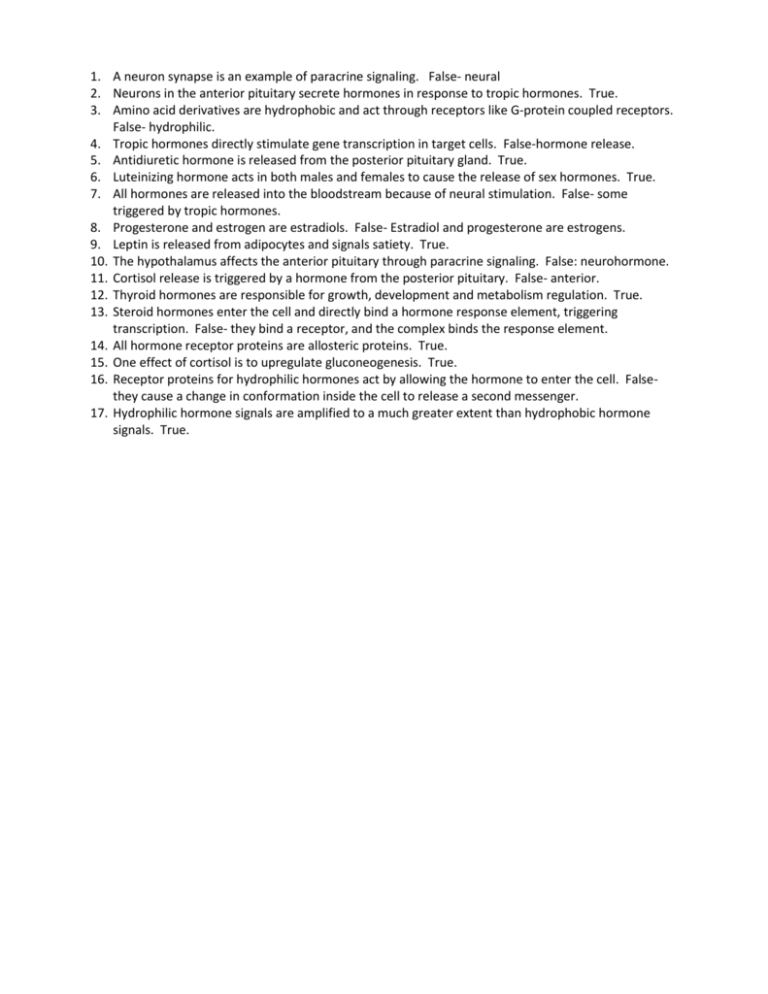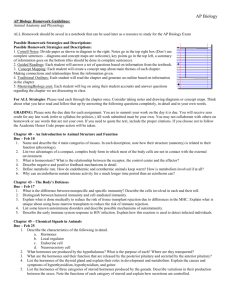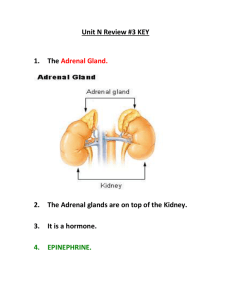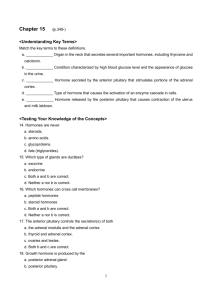1. A neuron synapse is an example of paracrine signaling. False
advertisement

1. A neuron synapse is an example of paracrine signaling. False- neural 2. Neurons in the anterior pituitary secrete hormones in response to tropic hormones. True. 3. Amino acid derivatives are hydrophobic and act through receptors like G-protein coupled receptors. False- hydrophilic. 4. Tropic hormones directly stimulate gene transcription in target cells. False-hormone release. 5. Antidiuretic hormone is released from the posterior pituitary gland. True. 6. Luteinizing hormone acts in both males and females to cause the release of sex hormones. True. 7. All hormones are released into the bloodstream because of neural stimulation. False- some triggered by tropic hormones. 8. Progesterone and estrogen are estradiols. False- Estradiol and progesterone are estrogens. 9. Leptin is released from adipocytes and signals satiety. True. 10. The hypothalamus affects the anterior pituitary through paracrine signaling. False: neurohormone. 11. Cortisol release is triggered by a hormone from the posterior pituitary. False- anterior. 12. Thyroid hormones are responsible for growth, development and metabolism regulation. True. 13. Steroid hormones enter the cell and directly bind a hormone response element, triggering transcription. False- they bind a receptor, and the complex binds the response element. 14. All hormone receptor proteins are allosteric proteins. True. 15. One effect of cortisol is to upregulate gluconeogenesis. True. 16. Receptor proteins for hydrophilic hormones act by allowing the hormone to enter the cell. Falsethey cause a change in conformation inside the cell to release a second messenger. 17. Hydrophilic hormone signals are amplified to a much greater extent than hydrophobic hormone signals. True. 1. You inject lab mice with two different hormones. One is a steroid, the other is an amino acid derivative. Which do you expect to have an effect with the smallest concentration? Why? a. Hydrophilic hormones must bind a receptor to signal in the cell. Most receptor mediated pathways include amplification steps, allowing a tiny amount of signal to have a large effect. Steroids, by contrast, enter the cell directly and often have much simpler pathways with less opportunity for amplification. Therefore, the amino acid derivative will probably have its effect at a lower concentration than the steroid will. 2. Compare and contrast the short term and long term stress responses. Short term Long term Medulla Cortex Sympathetic nervous system Sympathetic nervous system Epinephrine, norepinepherine Corticosteroids: glucocorticoids, mineralocorticoids, cortisol, aldosterone, Few minute halflife Long-lasting Increase blood to brain, heart muscles; decrease Increase water reabsorption in kidneys to increase blood to digestive system. Increase blood pressure, blood volume and blood pressure, release fatty cardiac output, alertness, breathing rate. acids into blood stream, gluconeogenesis (in liver Conversion of glycogen to glucose. from aa), lower immune response, pain, swelling. Use G-protein coupled receptor Bind receptors inside cells, begin protein synthesis Amino acid derivatives Steroids 3. Compare and contrast the mode of action of steroid hormones versus hydrophilic hormones like amino acid derivatives and polypeptides. a. Steroid hormones enter the cell by diffusion through the cell membrane. They then regulate gene transcription. They take a long time to act. Hydrophilic hormones cannot enter the cell and thus bind receptor proteins, notably G-protein coupled receptors. They have a variety of effects, tending to activate proteins already present in the cell or stimulate secretion of stuff already present. 4. Compare and contrast the anterior and posterior pituitary glands. a. The posterior pituitary contains the axon terminals of neurosecretary cells whose bodies are in the hypothalamus. Hormones released from the posterior pituitary are stimulated by neural impulse. Posterior releases ADH, oxytocin. Anterior pituitary is not neutrally linked to the hypothalamus, but contains many blood vessels. Neurons in the hypothalamus release ______ releasing hormone into the blood (a tropic hormone). Receptors on cells in the anterior pituitary bind these hormone molecules and release their own hormone into the blood stream. They release adrenocorticotropic hormone, FSH, LH, growth hormone, prolactin, and thyroid stimulating hormone. BOTH are under the control of the brain and of nerves in the hypothalamus. BOTH are subject to feedback inhibition. BOTH release products into the bloodstream. 5. Many professional athletes receive cortisone shots (a cortisol) when they are injured, allowing them to continue to compete. Why is this steroid not given orally as a long-term treatment for arthritis? a. Cortisol has many other effects, including depressing the immune system and increasing the availability of fatty acids for cellular metabolism. When given long-term and distributed through the circulatory system, it depresses the immune system. People (especially the elderly and otherwise vulnerable to infection) should not be chronically immunocompromised. Therefore, other treatments are preferred. 6. For this list of hormones, make a table stating where each is released from, how its release is triggered, its target organ(s) and what effects it has on the body. Focus on the ones covered in multiple units (like insulin, which we studied with digestion.) Where released How release Target organ Effect Epinephrine from triggered Adrenal gland Sympathetic medulla nervous system Variety Cause a shortterm stress response Corticosteriods Adrenal gland Receipt of cortex Adrenocorticotropic Variety Long term stress response hormone Androgens Estrogens Antidiuretic Male Receipt of follicle reproductive stimulating system hormones Female Receipt of follicle reproductive stimulating system hormones Posterior pituitary Stimulation by hormone erythropoietin Variety specific genes Variety Low blood oxygen Turn on femalespecific genes Kidneys hypothalamus Kidneys Turn on male- Insert aquaporins in collecting ducts Bone marrow Make more red blood cells Adrenocorticotropic Anterior pituitary Signal from Adrenal gland Stimulate release hypothalamus medulla of corticosteroids. Hypothalamus Signal from brain Anterior pituitary Release ACTH Pancreas High blood sugar Variety Increase glucose hormone Corticotrophin releasing hormone Insulin uptake glucagon Pancreas Low blood sugar Liver Convert glycogen to glucose Luteinizing Anterior pituitary hormone Signal from Female Regulate hypothalamus reproductive menstrual cycle system Follicle-stimulating Anterior pituitary hormone Prolactin Anterior pituitary Signal from Reproductive Release of sex hypothalamus system hormones Signal from Mammary glands Growth and milk hypothalamus Thyroid stimulating Anterior pituitary hormone Oxytocin Signal from production Thyroid gland Hormone release Stimulation by Female Labor and milk hypothalamus reproductive production hypothalamus Posterior pituitary system Growth hormone Anterior pituitary Signal from hypothalamus Variety Growth








